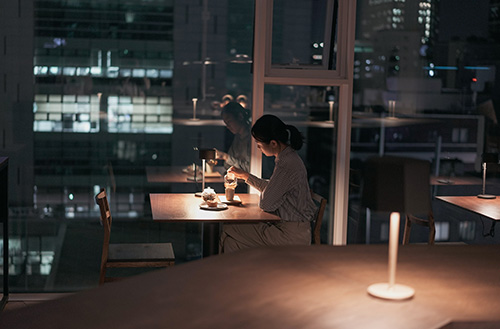

-
-
- 메일 공유
-
https://stories.amorepacific.com/en/when-stories-become-scent-the-linguistics-of-a-perfumer
When Stories Become Scent: The Linguistics of a Perfumer

When Stories Become Scent: The Linguistics of a Perfumer
Writer
Kim Yu-ra Perfumer of OVMUTE and Author

On top of a small desk dozens of fragrances rest. Between the firmly closed lids, an array of scents, each a different hue borrowed from nature, permeates the space. When I sit at the desk to work, the voices of these fragrances reach my ears: the bright laughter of Jeju Island's citrus blossoms, the cool whisper of Damyang's bamboo, and the sweet serenade of Goheung's yuzu. As I listen to each distinct olfactory note, droplets once separated inside tiny vials merge, creating a stratified, beautiful gradient. Delicately layered like translucent sheets, these fragrances converge to birth a singular language.

Scent, The Language of the Perfumer
Perfumery is a meticulous selection, blending, and refining process until the desired fragrance is achieved. It might seem straightforward, but to a perfumer, each scent is akin to a writer's word. Embedded in every droplet is a sentence crafted by the perfumer. Amongst the multitude of languages, the language of scents remains understated. It silently orbits our periphery, whispering in tranquil moments. An inadvertent whiff imprints on the brain, setting the atmosphere. Like the protagonist in “In Search of Lost Time,” who's transported to childhood by the scent of a Madeleine dipped in black tea, a scent's power to etch moments into our subconscious is unparalleled by any language.

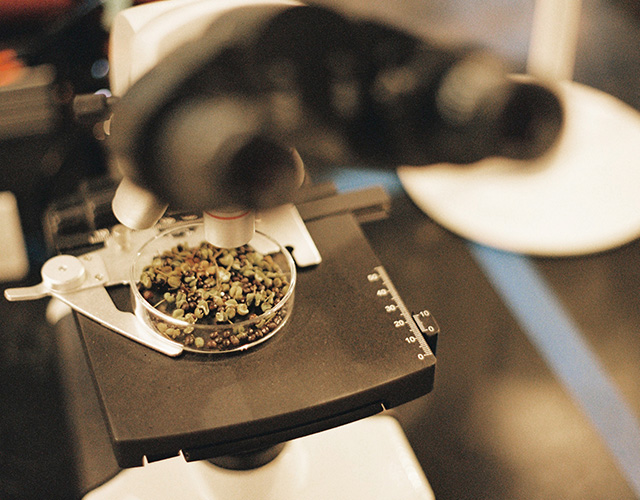
So, how is this potent, fully formed language of scent crafted? Predominantly, fragrances stem from natural essences extracted from animals and plants, and synthetic fragrances manufactured through chemical reactions. Neither can be declared superior. However, natural scents often become sources of inspiration and admiration for many perfumers. Yet, their prevalence in the perfumery palette remains limited. A significant reason is their exceptionally low yield. Various methods for extracting natural oils include distillation through heating, pressing, and volatile and non-volatile solvent extraction. Despite ongoing research to boost yields, extracting aromatic compounds from plants, some so elusive that even with great effort, only a drop of pure essence can be obtained, remains challenging. For instance, it's said that about 170 rose blossoms are required to produce just one drop of rose absolute, aptly dubbed the "queen of flowers." Given this, the use of comparatively affordable synthetic fragrances seems inevitable.
Having procured the fragrances, one must understand the 'time' inherent to each scent. In perfumery, 'time' correlates to molecular weight: lighter molecules surface initially, while heavier ones reveal themselves later. Much like grammar in a sentence, understanding the timing of these fragrances is crucial for crafting a communicative scent. Top notes frequently employ captivating citruses, like lemon and bergamot, whose effervescent and optimistic essences effortlessly draw one's attention. The heart of the scent, or the middle, represents the perfumer's core message, often dominated by resplendent florals substantial enough to serve as the fragrance's centerpiece. Finally, the base notes, lingering after-scent, feature the weighty and enduring woods or musks. They quietly support the other notes, sometimes overshadowed by preceding opulence, leaving a subtle, enduring trace.

Three Notes Found in the Perfumer's House
When one examines a dwelling, it is said one can discern the nature of its inhabitants. But could the reverse be true? Can we envision someone's home by merely observing them? When I first heard the title "The House of Perfumers," such was my paramount intrigue. I wondered, how does the space of a perfumer correlate with the scents he or she creates? Upon entering "The House of Perfumers," the realization was instantaneous: the perfumer resides in a home that mirrors the olfactory language he or she crafts. The atelier that welcomes one upon the ground floor is reminiscent of a top note — a space brimming with the perfumer's captivating visions.
A gently revolving turntable, antiquated vintage books laid out, and following the soft light pouring through the expansive windows, one’s gaze settles on an old-world perfumer's organ that seems stained with the patina of time. This organ, symbolic of a perfumer's profession, displays fragrances at a glance. By observing how these fragrances are organized and arranged, one can discern the perfumer’s method of work. The organ, said to be restored from the 1960s, spurs the imagination, making one ponder the hands it has passed through. Flowers and plants bursting into bloom exude a visual fragrance throughout the home. On closer examination, these turned out to be plants like roses and daffodils, ingredients of scents. Nature, blooming indoors. The dreamlike scents the perfumer paints using the essences derived from this nature are breathtaking, even in mere contemplation.
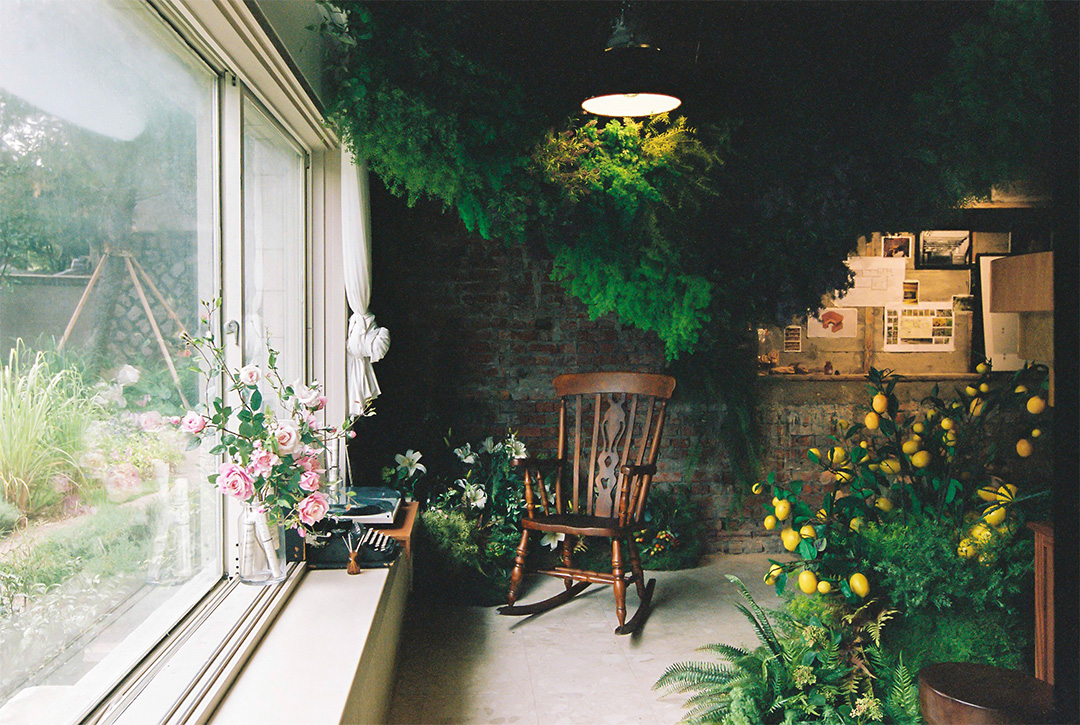
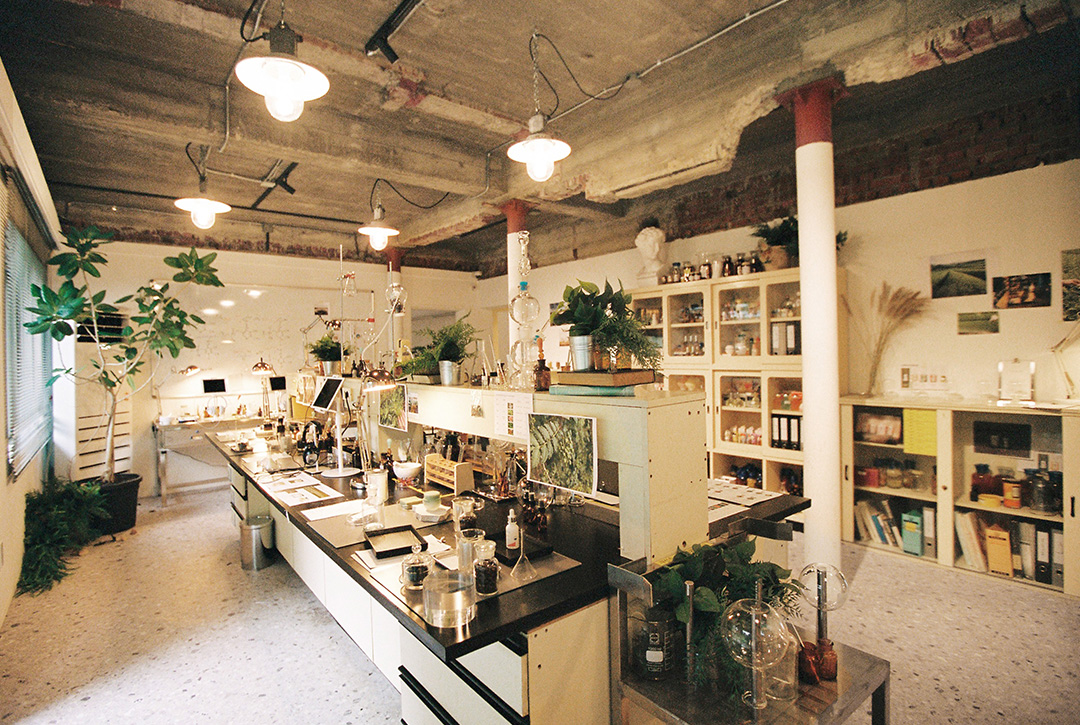
The second room, "The of Laboratory of Perfumers," encapsulates the middle notes. While the first room was undeniably enchanting, it didn't encompass the entirety of the perfumer's essence. There's no doubt perfumery is a sublime art. Yet, the first impression isn't all there is. Crafting artistic fragrances is impromptu, following fleeting inspirations, and meticulously birthed from rigorous research and planning. In the laboratory, one could glimpse the actual workspace of the perfumer, stripped of mysticism. The furniture reportedly brought from the Amorepacific research lab bore time marks. Additionally, the scattered hastily written notes and experimental equipment made it feel as if a workspace from the past was transplanted wholesale. Particularly striking was a wall filled with seeds of raw plant materials and a map on the desk highlighting natural sources. Amorepacific is said to extract botanical ingredients from various regions in Korea and incorporate them back into their products, predominantly featuring quintessentially Korean fragrances like ginseng and yuzu. The significance was palpable in that since the 1970s, research using Korean plants and scents has been conducted, and products developed accordingly. As previously mentioned, the profitability of natural scents is relatively low. The cost required for extraction and research is substantial. However, combinations of synthetic fragrances still majorly rely on natural scents, evolving through research on them. With so many unknown fragrances yet to be explored, research on natural scents is indispensable if one yearns for the evolved fragrances of the future. This underscores the continued necessity of research and interest in natural ingredients.
The term "Perfumery" is not just about crafting scents; at its core, it signifies much more than that. The prominence of fragrance in Korea is relatively recent. Although fragrances have been enjoyed for a long time, when extracting ingredients and developing scents, Korea could have been considered barren ground. For instance, when Amorepacific's fragrance team began its in-house scent development and studies abroad in the 60s and 70s, many were unfamiliar with the concept of "Perfumery." While fragrances garner attention now, the proactive research on fragrances that began more than 50 years ago, which didn't merely follow foreign trends but sought out Korean plants and scents and archived them, was quite astonishing. People invest time and capital into what they value. Had they merely chased the allure of fragrance as a simple consumer product, they couldn't have devoted themselves to scent research. Perhaps the essence of “Perfumery” is pursuing a sustainable future for fragrances.
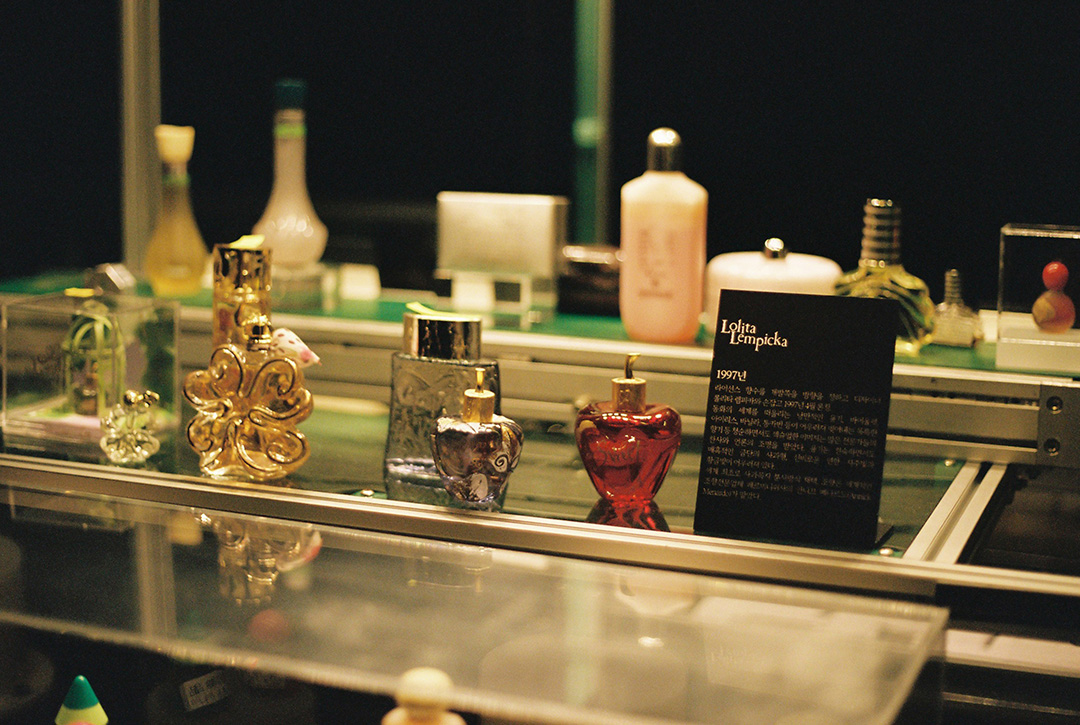
After the top and middle notes, I felt the lingering scent in the final space, "Scent Archive." This subtle presence of an after-scent doesn't clamor for attention, and people often overlook it. However, without the foundational role of roots that solidify the ground, the preceding scents would vanish in a heartbeat. In the Scent Archive, one could encounter vintage fragrances of Amorepacific, showcasing the past and present of Korean scent culture and industry. Hundreds of formula samples were stacked from an unknown period, vintage filling machines still operated, and dozens of perfume bottles revealed the passage of time through their design. Some still opine that Korean fragrances have a long way to go. But, watching interviews with the perfumers, one realizes there have always been individuals who relentlessly collected and researched scents, even in unnoticed currents. There were endeavors like researching traditional Korean medicinal herbs for new scents in cosmetics or analyzing the ingredients of a freshly bloomed rose to enhance its appeal. Even the fragrances of products we casually pass by in our daily lives are born out of such meticulous research. One wonders what story a scent released in Korea about 50 years ago would tell. One thing is for sure: the contemplations and research gathered over decades made the present possible.

The Tale Scents Leave Behind
A good perfumer communicates through scents, unraveling compelling stories. Following the flowing, seamless narrative in "The House of Perfumers," it was evident that the owner of this house crafts sentences with scents, an eloquent storyteller in their right. This space allowed an intuitive glimpse into the perfumer's world, translating the olfactory language into visual nuances. One can't help but anticipate what stories the perfumer's future fragrances might tell.
epilogue
Kim Yu-ra. As the perfumer of the fragrance brand "OVMUTE" and an author, she creates and blends scents based on art and nature. She believes in the intangible beauty in fleeting moments, capturing the fluctuating senses in her scents.
Written Kim Yu-ra
Photos Amorepacific
Planning Amorepacific Communications Team
-
Like
0 -
Recommend
1 -
Thumbs up
0 -
Supporting
0 -
Want follow-up article
0



